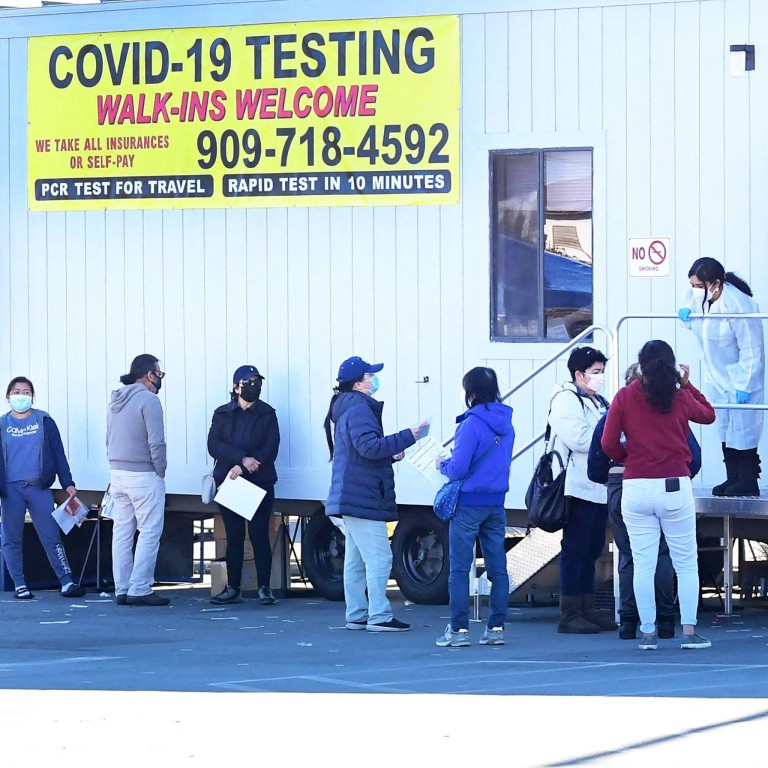
Joe Biden says US on right track in coronavirus fight even as new cases hit record 1.35 million
- Scientists say the true tally may have hit a peak of 6 million daily infections as cases go undetected due to asymptomatic patients and lack of testing
- Omicron was estimated to account for 98.3 per cent of total new Covid-19 infections in the country as of January 8
Biden, who has been accused of focusing on vaccinations at the expense of testing and support for struggling health care systems, told reporters on Tuesday he was “confident we’re on the right track” to fight the pandemic.
The United States reported 1.35 million new coronavirus infections on Monday, according to a Reuters tally, the highest daily total for any country in the world.
Omicron was estimated to account for 98.3 per cent of total new coronavirus cases circulating in the country as of January 8, the US Centres for Disease Control and Prevention (CDC) said on Tuesday.

There were more than 135,500 people hospitalised with Covid-19, surpassing the record of 132,051 set in January last year. The surge in cases and hospitalisations has forced Americans to cancel travel plans, closed entertainment venues, and scrambled plans for students and teachers to return to school and workers to go back to the office.
A closely watched projection from the Institute for Health Metrics and Evaluation (IHME) at the University of Washington estimates that number is far higher due to the likelihood that many more infections go undetected, either because people are without symptoms or do not have access to testing.
As a result, the IHME model suggests that the US surge fuelled largely by Omicron may have already hit a daily peak of more than 6 million cases, and could drop significantly from that point by the end of this month. But disruptions to health systems, schools and businesses might not resolve quickly even as infections decrease.
After nearly a month of rising Covid-19 case numbers in New York state, Governor Kathy Hochul said on Tuesday that the tide might be turning.
New York sees signs of Omicron peak, though ICUs remain pressured
While daily new infections remain high with 48,686 new cases reported on Monday, Hochul said the downward trajectory offered a “glimmer of hope”. “Looks like we might be cresting over that peak,” the governor said at a news conference.
The Red Cross declared a national blood crisis, with a 10 per cent decline in the number of people donating blood. It noted the pandemic has led to blood drive cancellations and staffing limitations.
“Adding to the concern is the surge of Covid-19 cases,” the Red Cross said. “The Red Cross has experienced low donor turnout ever since the Delta variant began spreading in August, and that trend continues as the Omicron variant takes over.”
Dr. Rochelle Walensky, director of the Centres for Disease Control and Prevention (CDC), said the country has the tools needed to fight the fast-spreading variant.
“We are working quickly to adapt to it,” Walensky told the Senate Health, Labour, Education and Pensions Committee on Tuesday.
In Chicago, public school teachers reached an agreement on Covid-19 safeguards with the district, ending a walkout that cancelled classes across the third largest school system in the United States for a week.
The system’s 340,000 students are due back to school on Wednesday after the Chicago Teachers Union’s House of Delegates voted on Monday night to end the weeklong walkout over Covid-19 fears.
The walkout began with a union vote to reinstate virtual instruction and a push for more rigorous safety protocols, including wider testing, as the Omicron variant spread.
New vaccines – not repeated boosters – needed for Omicron, WHO experts say
While most US public school districts have reopened their campuses for the new year, education systems in some major cities have opted for online learning or delayed back-to-classroom plans due to staff shortages, in some cases caused by Covid-19.
In Chicago, where the seven-day average of cases showed indications of a decrease last week, dropping 8 per cent since the week prior that saw 5,200 cases, Mayor Lori Lightfoot has pushed for schools to remain open.
“Switching completely back to remote learning again without a public health reason to do so would have created and amplified the social, emotional and economic turmoil that far too many of our families are facing,” she said at a news conference.
The dispute was tense. Lightfoot and the district had branded the walkout illegal and said teachers’ pay would be docked.

The union had accused the mayor and school officials of “locking out” teachers by freezing their online instruction platforms.
The agreement calls for increased testing and contact tracing in schools, creates metrics for the district to go remote and includes a commitment to secure additional KN95 masks for staff and students, the Chicago Tribune reported.
During a news conference on Monday, Chicago Teachers Union President Jesse Sharkey said the deal was not ideal but “it does include some important things which are going to help safeguard ourselves and our schools”.
In New York, some students planned to walk out of their classrooms on Tuesday over Covid-19 concerns, according to social media posts.

